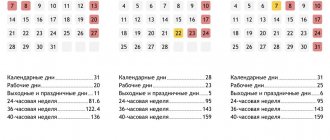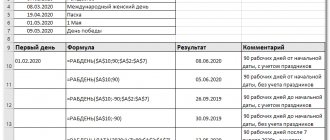Labor legislation provides for a standard work schedule, which is a five-day working week (Article 91 of the Labor Code of the Russian Federation).
All other by-laws applicable in labor relations are based on a five-day work schedule.
The employer has the right to deviate from the general rules established by law by drawing up appropriate local administrative documentation with a mandatory indication of the reason for such deviation.
Payment for days off during a five-day work week
With a 5-day work week, workers have two days off per week; the usual days off are Saturday and Sunday, and rarely Sunday and Monday. In some cases, the employer may establish a work schedule at the enterprise in which generally accepted weekends are working days. For example, during shift work, weekends are set by the shift schedule and are “floating”, that is, they can fall on different days of the week, taking into account the alternation of shifts. Sometimes the following situations occur: an employee works on a standard schedule of a five-day workweek with two days off, but the employer needs the employee to go to work on his day off. To do this, the following conditions must be met.
- In order for employees to go to work on their day off, the employer must have a legal basis;
- the employee’s written consent will be required (exceptions are provided);
- it is necessary to take into account the opinion of the trade union (in some cases established by law);
- You will need a written order from the employer.
It is worth keeping in mind that the payment for “working” days off with a five-day work week will be increased, or you can compensate for them with a day of rest additionally provided to the employee. However, in this case there are exceptions: they apply to employees with whom an employment contract has been concluded for a period of up to 2 months. In this case, if you ask an employee to go to work on his day off, you can only compensate for his work in monetary terms and at least double the amount.
What is a flexible work schedule?
Article 100 of the Labor Code of the Russian Federation provides for several types of labor regulations:
- five-day work week with two days off;
- six-day work week with one day off;
- part-time work week;
- flexitime.
The specifics of the activities of some organizations provide for the provision of days off on a sliding schedule. This happens in companies that work seven days a week. Due to this regime, as a rule, it is impossible to comply with working hours. Therefore, such enterprises should use summarized recording of working hours.
This is what a sliding work schedule for guards in a kindergarten might look like for February 2021 (3 people work, the presence of a guard on a weekday is required for 12 hours, on a weekend - 24 hours).
According to Article 104 of the Labor Code of the Russian Federation, in this case the accounting period cannot exceed 1 year, and for employees employed in hazardous and hazardous industries - 3 months. If, for seasonal or technological reasons, the duration of the accounting period for employees of harmful and hazardous industries cannot be observed, then its duration can be increased to 1 year. For this purpose, intersectoral or collective agreements are drawn up.
Order on the transition to a five-day working week
If you want to increase or decrease the length of the working week, you must adhere to the following procedure:
1. Issue an order to switch to a different work schedule (five-day working week). The order must be drawn up in free form.
The order must indicate:
- a list of positions, professions or individual employees for which a new work schedule is established, for example, a five-day work week;
- the procedure for introducing a five-day working week;
- a list of employees who are responsible for the introduction of a five-day working week;
- deadlines for order execution.
Employees, if they switch to a new work schedule, must be familiarized with the order.
An example of an order to switch to a five-day work week:
Non-working holidays in the Russian Federation
Public holidays in 2021 are official holidays and are indicated in the production calendar.
Which holidays have been declared non-working days throughout the country in 2021:
- January 1, 2, 3, 4, 5, 6 and 8 — New Year holidays;
- January 7—Christmas Day;
- February 23 - Defender of the Fatherland Day;
- March 8—International Women's Day;
- May 1 - Spring and Labor Day;
- May 9 - Victory Day;
- June 12—Russia Day;
- November 4 is National Unity Day.
prikaz.gif
2. Establish a different length of the working week (for example, five days or six days) in the internal labor regulations (collective agreement). Changes to the Internal Labor Regulations are formalized by order of the head of the enterprise or a person authorized by him, and in a collective agreement - by an additional agreement to it. All employees must be familiarized with all changes made to the Internal Labor Regulations or their new edition by signature.
3. Reflect the transition to a different length of the working week in employment contracts with employees for whom it is established, by drawing up additional agreements to employment contracts.
Flexible, replaceable or sliding
In business and personnel practice, these concepts often cause confusion and confusion.
We see that they are regulated by different articles of the Labor Code, which means they have serious differences in documentation, payment and approach to accounting.
Comparison with flexible schedule
Sometimes the concepts of “flexible” and “sliding” schedules are used interchangeably. In some legislative acts, especially those that have not undergone significant changes since Soviet times, this is directly reflected in the title, for example, Resolution of the State Committee for Labor of the USSR and the Secretariat of the All-Union Central Council of Trade Unions dated 06.06.1984 No. 1701/10-101 “On approval of the Regulations on the procedure and conditions for the application of a sliding (flexible) work schedule for women with children.”
However, these two types of graphs cannot be identified. It would be more accurate to say that any flexible schedule is flexible, but not any flexible schedule is necessarily flexible.
Sliding and rotating schedules
The shift schedule is characterized by continuous production and work shifts of several shifts per day. Weekends in this mode also shift, which is the reason why it is confused with sliding. But with a shift schedule, a shift in days off occurs when the total recording of working time for the accounting period shows overtime (Part 3 of Article 111 of the Labor Code of the Russian Federation).
How to determine the standard working hours with a sliding work schedule ?
Differences between a sliding schedule and a flexible and shift schedule
The main distinctive features of these three types of working time organization are shown in Table 1.
| № | Base | Flexitime | Flexible schedule | Shift work |
| 1. | Start and end of the working day | According to the work schedule | Can be rescheduled at the discretion of the employee | According to the shift schedule |
| 2. | Work on holidays | A full day of work, if it falls on schedule, is usually paid | By agreement with the employee | Paid at double rate or compensated by additional days off |
| 3. | Time tracking | Total - for the reporting period should not exceed the number of hours established by the Government. | ||
| 4. | Familiarization with the schedule | No specific time frame | Agreed between employee and employer | No less than a month |
| 5. | Is it possible to refuse to work on a certain day? | It is forbidden | Can | Can be replaced on another working day (“swap shifts”) |
Long weekend in the 2021 work calendar
Production calendar 2021 with holidays and weekends in table
| Calendar month | How many days are there in a month | ||
| workers | weekend | holiday | |
| January | 15 | 8 | 8 |
| February | 19 | 8 | 1 |
| March | 22 | 8 | 1 |
| April | 22 | 8 | |
| May | 19 | 10 | 2 |
| June | 21 | 8 | 1 |
| July | 22 | 9 | |
| August | 22 | 9 | |
| September | 22 | 8 | |
| October | 21 | 10 | |
| November | 20 | 9 | 1 |
| December | 22 | 9 | |
The longest weekend falls on the New Year holidays 2021, as we rest on other holidays, the production calendar will show.
Number of long weekends in 2021 in the table.
| Dates | Amount of days |
| January 1—10 | 10 |
| 21 – 23 February | 3 |
| 6 – 8 March | 3 |
| may 13 | 3 |
| 8 – 10 May | 3 |
| 12 – 14 June | 3 |
| 4 – 7 November | 4 |
| Shortened working days in 2021 20.02, 30.04, 11.06 and 3.11 are pre-holiday days in 2021. The duration of work on these days is reduced by one hour. |
Weekend transfers 2021
By Resolution No. 1648 “On the postponement of holidays in 2021”, the 2021 production calendar was approved by the Government of the Russian Federation.
The following days have been postponed:
- Saturday 2 January → Friday 5 November;
- Sunday January 3 → Friday December 31;
- Saturday 20 February → Monday 22 February.
Holidays that coincided with weekends have been postponed:
- Saturday 1 May → Monday 3 May
- Sunday 9 May → Monday 10 May
- Saturday 12 June → Monday 14 June
Which weeks are shortened in the 2021 work calendar?
In February, the last week of the month will be shortened. February 22 and 23 are holidays, three working days remain.
The second week of March has also been shortened to four days - we rest on Monday, March 8th.
In May we will have two shortened weeks. These are the second and third weeks of the month. The weekend of May 3 and May 10 falls on Mondays.
In 2021, the production calendar for 2021, approved by the government of the Russian Federation, will delight us with a holiday on Monday - the third week of June will also begin with a holiday. This is a rescheduled Russia Day, falling on Saturday. In total, we rest for three days in June - June 12, 13, 14.
The next short week in 2021 will be in November. The reduction is due to National Unity Day, celebrated on the 4th. There are three working days - November 1, 2 and 3, four days off - from 4 to 7.
The last week of the year is also four days. December 31 is an official holiday.
| The 2021 production calendar has not only shortened weeks, but also an extended one: from 02/15 to 02/20/2021 - six working days, since February 22 is moved to Saturday 20. |
Working hours and schedule: all the principles of proper organization of work routines
The work of hired workers in different spheres of economic activity requires completely different schedules of their involvement in the work process. If office workers work, as a rule, under conditions of a five- or six-day work week, then, for example, the service sector requires a completely different regime.
A schedule is drawn up for each employee, which may include night work, shifts, and “floating” days off. In the meantime, it is impossible to draw up a schedule, guided only by the own wishes of the employer and employee - there are a lot of rules that are enshrined in labor legislation. Table of contents Time worked is the basis for remuneration for employees with a time-based payment condition. Labor law obliges the employer to keep strict records of working time for each employee, after all, it is during time (with the exception of quite rare cases of piecework) that payment for work occurs.
Working time schedule for 2021 (timesheet): how to fill it out
There are two unified forms: T-12 and T-13. The difference between them is that the T-12 form is filled out only manually or in a text editor, and it has a special section for calculating wages. Timesheet T-13 can be filled out using specialized computer programs and access control systems, which are used to record visits by company employees to their work. This form does not have a block for calculating wages; it must be calculated in other registers.
The time sheet is the primary document on the basis of which employees’ wages, payments from them and additional payments accepted in the organization are calculated. Since the listed payments reduce corporate income tax or taxable income under the simplified tax system, the document should be fixed as a primary document in the organization’s accounting policy. It is not necessary to use the unified form from 01/01/2013. It is important to consolidate your own version of the form in the accounting policy and ensure that it contains all the necessary details, the mandatory presence of which for primary documents is established by law 402-FZ.
The time sheet is drawn up in one copy by a person authorized to monitor the control of working hours throughout the organization or in a separate structural unit. The list of persons signing it is established by the internal administrative act of the organization. At the end of each month, the completed timesheet is transferred to the accounting department.
Let's look at the procedure for filling out the timesheet using the T-13 form as an example.
The name of the organization and structural unit must be filled in the header (when monitoring working hours in structural units). The serial number is assigned in accordance with the accepted numbering in the organization. The date of compilation and the reporting period must be filled in as details of the primary document.
You can download a sample work schedule in Excel at the end of the article. Now let’s look at how to calculate a work schedule and draw it up correctly.











